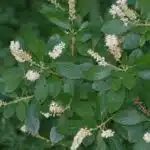Tea olives (Osmanthus fragrans) are a beautiful and fragrant evergreen shrub that can add a colorful accent to any garden. These tough and hardy plants not only look beautiful, but also provide an intoxicating scent that will linger in the air for miles around. With their unique shapes and attractive foliage, tea olives can make a great addition to any outdoor space. Whether you’re looking for a low-maintenance plant or something with more of an impact, tea olives can be just the thing to bring your landscaping dreams to life.
But growing and caring for tea olive trees isn’t always easy. Without proper attention, they may become overgrown or succumb to disease or pests. In order to ensure that your tea olives remain healthy and vibrant in your garden, it is important to understand what they need in terms of soil, watering, pruning, fertilizing and other essential care tips.
In this article, you will learn how to grow and care for tea olive shrubs so that you can enjoy their beauty and fragrance year after year. From planting the shrubs in the right location to keeping them free from disease or pests – you will find all the information you need here! So let’s get started on our journey towards perfecting your outdoor oasis!
What Is A Tea Olive Shrub?
Tea olives are like the shining stars of the garden, radiating their beauty and fragrance far and wide. They’re a delight to look at and smell – what more could you ask for in a shrub? A tea olive is an evergreen flowering shrub that blooms fragrant flowers in late winter and early spring, adding color to your garden until late summer when its glossy leaves become a deep green hue.
The best thing about these hardy shrubs is that they require minimal maintenance. Tea olives prefer full sun or partial shade, they thrive in acidic soil and can tolerate drought-like conditions. A regular pruning will help keep them looking neat and healthy without affecting their flowering season. Regular watering during dry spells is also important to ensure lush foliage and vibrant blooms.
Taking care of tea olive shrubs doesn’t have to be complicated – just follow a few simple steps and you’ll have happy, healthy plants! With proper care, these beautiful shrubs can make any garden into something special. So why not give them a try? You won’t regret it!
Planting Tea Olive Shrubs
It’s time to plant our tea olive shrubs! It’s a great choice for a garden, as it adds a nice touch of color and fragrance. Planting these shrubs is relatively simple, but there are a few things to consider before you begin.
First, determine the right location for your tea olives. You’ll want to find an area that gets plenty of sunlight during the day and is well-drained so the roots don’t become waterlogged. Tea olives are also tolerant of most soils types, as long as they’re not overly wet or dry.
Once you’ve chosen the location, dig a hole twice as wide and twice as deep as the root ball of your shrub. Place the shrub in the center of the hole and fill it back up with soil from the excavation. Make sure you tamp down lightly around the root ball so that it is firmly in place. Water deeply after planting and mulch around the base of your tea olive to help retain moisture and reduce weeds.
Now that we’ve planted our tea olive shrubs, let’s discover how to select a location for them where they will thrive!
Selecting A Location For Tea Olive Shrubs
Are you wondering how to select the right location for your tea olive shrubs? After all, it’s a crucial step in ensuring that your shrubs grow healthy and strong. Let’s look at some factors to consider when deciding where to plant your tea olives.
When selecting a location, pay attention to sunlight requirements. Tea olives are tolerant of both full sun and partial shade, but they may flower more abundantly in full sun. In addition, be sure to choose an area with well-draining soil; these shrubs don’t tolerate standing water. If you have heavy clay soil, it’s best to amend it with organic material before planting your shrubs.
Finally, keep in mind that tea olives are slow-growing and long-lived plants. Therefore, pick a spot where the shrubs can stay undisturbed for many years. For example, avoid areas near sidewalks or patios where you might need to dig up the roots for repairs or maintenance.
Now that we’ve discussed how to select a suitable location for your tea olive shrubs, let’s move on to preparing the soil for them.
Preparing The Soil For Tea Olive Shrubs
So you’ve decided to grow and care for tea olive shrubs, and the fourth step in this process is preparing the soil. It’s essential that you prepare the soil properly in order to get the best results from your shrub. Here’s what you need to do:
First, check your soil pH level. Tea olives prefer slightly acidic soil with a pH between 6 and 7.5. If it’s too alkaline, amend it with sulfur or elemental sulfur to lower the pH level.
Next, add organic matter like compost or manure to improve the drainage and aeration of your soil. This will help keep your tea olive healthy even during periods of prolonged rain or drought. Finally, work in a slow-release fertilizer before planting and water regularly throughout its life cycle.
These steps are critical for any garden project whether you’re growing tea olives or another type of plant, so make sure you follow them carefully! With these preparations in place, you’re ready to start planting your tea olive shrubs!
Planting Tea Olive Shrubs
You may think that planting tea olive shrubs is a daunting task, but with the tips outlined here, you’ll be growing some of the most stunningly fragrant plants imaginable in no time! To ensure your shrubs are off to a great start, let’s explore what you need to know about planting them.
First, it’s important to make sure your soil is well-draining. If it isn’t, consider adding organic matter such as compost or manure to help improve its quality. Once you have the soil ready for planting, here are some things to keep in mind:
• Select healthy plants with root systems that look fresh and undamaged. • Plant at the same depth as they were originally grown — too deep or shallow can cause problems down the line. • Space your plants accordingly — tea olives don’t require a lot of space so feel free to get creative! • Water thoroughly after planting and during the first few weeks while they’re getting established.
With these considerations in mind, you’re now ready to get started on bringing these beautiful shrubs into your garden! As they begin their journey of growth and development in their new home, it’s essential to understand how best to care for them by providing adequate water and fertilizer. Let’s take a look at that next!
Watering And Fertilizing Tea Olive Shrubs
Once you have your tea olive shrub planted, it’s important to ensure that it is well taken care of. Regular watering and fertilization are essential if you want to keep your shrub healthy and thriving.
When it comes to watering, tea olive shrubs require a lot of moisture. Watering the shrub twice a week is ideal during the summer months. During the winter, you should reduce the amount of water you give it since the soil tends to stay wet for longer periods of time. It’s also important to make sure that you’re not over-watering your shrub as this can cause root rot.
When it comes to fertilizing, use a balanced fertilizer once every three months or so in order to provide the necessary nutrients for optimal growth. Make sure that you read and follow all instructions on the packaging carefully before applying any fertilizer. Additionally, make sure that you are not over-fertilizing your tea olive shrub as this can lead to nutrient deficiency and other problems with its growth.
Taking proper care of your tea olive shrub will help ensure that it grows strong and healthy for many years to come. With regular watering and fertilization, coupled with some pruning here and there, your tea olive shrub will be able to thrive in its new home.
Pruning Tea Olive Shrubs
The beauty of a Tea Olive shrub is undeniable, but what can you do to make sure it remains healthy and vibrant? Pruning is one of the key components to keeping your shrub in top condition. But how exactly should you prune a Tea Olive shrub?
You’ll be surprised by the unexpected ways pruning can benefit your Tea Olive shrub. Not only does it help keep its shape, but it also encourages more blooms and even stimulates growth in areas where the bush is looking a bit sparse. Pruning also helps control the size of the plant, which means you don’t have to worry about it taking up too much space.
There are several different techniques when it comes to pruning a Tea Olive shrub, so it’s important to understand which method works best for your particular situation. To ensure success, start with light pruning and then follow up with heavier cuts as needed. You’ll want to remove any dead or diseased branches, as well as any shoots that are growing inwards towards the center of the bush. Be sure not to over-prune or else you run the risk of stunting your shrub’s growth. With these tips in mind, you can easily maintain a healthy and beautiful Tea Olive Shrub!
Pruning isn’t just about aesthetics; it also plays an important role in controlling pests and diseases from affecting your Tea Olive Shrub. By removing any weak branches or ones that are overcrowded with foliage, you can limit insect infestation and disease spread. Additionally, keeping an eye out for signs of damage such as discolored leaves or wilting branches will help prevent serious problems from occurring down the line.
Controlling Pests And Diseases
A lush, green tea olive shrub is a beautiful sight to behold. But, like all plants, it needs extra care and attention to ensure its health and robustness. Controlling pests and diseases is one of the key steps to achieving this goal.
The most common pests and diseases of tea olive shrubs can vary depending on the region in which they are grown. Aphids, mites, scale insects, caterpillars, whiteflies, and borers can cause damage to the leaves or stems of the shrub. Fungal diseases such as powdery mildew or leaf spot can also affect tea olives if conditions are favorable for their growth.
Fortunately, many of these problems can be addressed through proactive gardening practices such as regular pruning and monitoring for signs of infestation. When dealing with an insect infestation, you may need to use chemical treatments such as insecticides or horticultural oils to clear them out. Similarly, fungicides may be necessary if a fungal infection has taken hold of your tea olive shrub. Knowing how to recognize these problems early will help you keep your shrubs healthy and thriving.
By taking proper care of your tea olive shrubs through pruning and pest control techniques, you can provide them with the best chance at success and maintain their beauty for years to come.
Common Pests And Diseases Of Tea Olive Shrubs
Tea olive shrubs bring vibrant blooms and a pleasant, fragrant aroma to any garden. While these plants are typically easy to care for, it’s essential to know about the potential pests and diseases that may affect them. Here are some interesting facts: on average, tea olives are susceptible to around 15 different types of pests and diseases, with the most common being scale insects and powdery mildew.
To keep your tea olive shrubs healthy and thriving, here are three steps to take if you see one or more of these symptoms:
- Inspect your plant frequently for signs of infestation such as wilting leaves or abnormal growth.
- Prune off affected branches or leaves immediately after spotting the damage.
- Treat the shrub with an appropriate insecticide or fungicide if needed.
It’s also important to be aware of cultural practices that can reduce the risk of pests and diseases on tea olive shrubs. These include keeping the soil moist but not soggy, pruning away overly dense foliage, and applying fertilizer regularly in spring and summer months. Taking a proactive approach in caring for your tea olives is key in ensuring their health over their lifetime – so make sure you give them all the love they deserve!
Propagating Tea Olive Shrubs
Propagating tea olive shrubs is an economical and rewarding way to increase your stock of these beautiful plants. For instance, you can get a larger yield of tea olive shrubs without buying more expensive specimens from the nursery. Here are some tips and tricks to help you with your propagation project.
First, take cuttings from a healthy parent bush in late spring or early summer when growth is most active. You’ll want to make sure each cutting is about 4-6 inches long, has at least two leaves, and includes several sets of buds. Then, prepare a potting mix for the cuttings by combining equal parts peat moss, perlite, and coarse sand or vermiculite. Plant each cutting vertically with 1/3 of its length below the soil line.
Water thoroughly after planting and keep the soil moist until roots have established themselves in the ground. Place the potted cuttings where they will receive indirect sunlight while they root over a period of 3-4 months. Feed them regularly with diluted liquid fertilizer to help promote strong growth during this time.
Propagating tea olive shrubs doesn’t require any special skill or expertise but it does require patience and care to ensure success. With some attention and effort, you can enjoy many new plants that are clones of their parent—without spending extra money on purchasing them from a nursery!
Growing Tea Olive Shrubs In Containers
Growing tea olive shrubs in containers is like planting a garden in miniature pots; it requires careful thought and consideration but can be incredibly rewarding. You don’t always need a large garden to add beauty and fragrance to your home. Growing tea olives in containers is an ideal way to bring the beauty of these plants into your home.
When growing tea olives in containers, you’ll want to use pots that are large enough for their root systems. The soil should also be kept slightly moist, not wet, at all times. If the soil is too dry, the leaves may become brown or yellowish, and if overly wet, the roots will rot. Make sure you check the potting soil regularly and that it has enough drainage holes so excess water can escape. To help keep your container-grown tea olive healthy, provide plenty of bright sunlight and feed them with a balanced fertilizer every few weeks during the spring and summer months.
Finally, while they thrive on their own when grown in containers, companion planting with other shrubs can give your tea olives an even better environment for growth. Consider pairing them with dwarf shrubs such as boxwood or evergreens for best results; this will create an attractive display of texture and color!
Companion Planting With Tea Olive Shrubs
The beauty of companion planting with tea olive shrubs is that it creates a mesmerizing sight – an artful mix of colors, textures and shapes. Imagine a garden full of vibrant azaleas, bright yellow coreopsis, and stately tea olives intertwined in perfect harmony. It’s enough to take your breath away!
There are three main benefits to companion planting with tea olives. First, it helps create a diverse ecosystem which supports beneficial insects like bees and butterflies. Second, companion plants can provide shade for the delicate leaves of the tea olive shrub. Third, they help keep weeds from overtaking the area and competing for water and nutrients.
Companion planting with tea olives is an easy way to enhance your garden while also helping to support its overall health. As you choose companion plants for your tea olive shrub, pick ones that will thrive in your particular climate and soil type. With careful planning and attention, you can create a stunning landscape feature that will bring joy for years to come!
Uses For Tea Olive Shrubs
It may sound counter-intuitive, but tea olive shrubs have some remarkable uses beyond the obvious. Far from being just a fragrant addition to any garden, these hardy evergreen plants are actually quite versatile! Believe it or not, they can be used for much more than simply providing a pleasant aroma.
From providing shade and privacy to aiding in erosion control, tea olives can make a huge difference in your yard – as long as you know how to care for them properly. They are known for their ability to withstand drought and windy conditions, so they are perfect for areas that don’t get much rain or sun. Plus, their thick foliage makes them great at blocking out noise and providing a sense of privacy.
But that’s not all; tea olives can also be used in natural pest control! They make an excellent choice for organic gardens since the leaves contain oils that repel harmful insects like aphids and mites. The strong scent of the flowers is also known to keep away deer, rabbits, and other small critters.
Tea olives are truly amazing plants with numerous uses – so why not give one a try? With proper care and maintenance, you’ll soon have a beautiful garden full of these evergreen shrubs that will provide you with pleasure and practicality for years to come!
Harvesting Tea Olive Shrubs
Harvesting tea olive shrubs is a great way to bring the sweet, fragrant blooms indoors and make a lovely addition to any bouquet. With just a few simple steps, you can easily enjoy the fruits of your labor. Here’s how:
First, it’s important to harvest at the right time. Tea olives usually bloom in late fall or early winter, so try to pick when the flowers are in full bloom for maximum impact. Second, use sharp pruners or scissors to snip off individual flowers or branches from the shrub. Make sure you don’t damage any stems and that you’re not taking too much from one spot on the shrub. Finally, pick up any fallen petals or leaves immediately to prevent them from becoming a breeding ground for insects and mold.
Once you’ve harvested your tea olive blooms, there are lots of ways to enjoy them indoors! You can use them as a centerpiece in a vase or mix with other flowers like roses and daisies for a unique floral arrangement. They also look beautiful scattered around candles on dining tables or used as decorations during special occasions like weddings and birthdays.
With some creativity and effort, tea olives can be transformed into something truly extraordinary – now let’s explore some design ideas for tea olive shrubs!
Design Ideas For Tea Olive Shrubs
Beauty is omnipresent in nature and it can be easily seen with Tea Olive Trees! The magnificent shrub brings life to any garden with its stunning foliage and fragrant flowers. But how do you make the most of this stunning beauty? Design ideas for Tea Olive Shrubs are here to help!
From topiaries to hedges, the possibilities for creating a gorgeous outdoor space with Tea Olive Shrubs are seemingly endless! Topiaries bring an old-world feel to gardens through their intricate shapes, while hedges provide a beautiful backdrop that’s perfect for framing flower beds or walkways. You can even trim your Tea Olives into evergreen trees, adding structure and height to your landscape.
But don’t forget – pruning is key! Pruning helps keep Tea Olives looking their best and encourages new growth. With the right care, this low-maintenance shrub will always look its best. Your outdoor space will be overflowing with mesmerizing beauty all year round! TIP: Be sure to use gloves when pruning your Tea Olives and consider using shears instead of hedge trimmers as shears will give a smoother cut.
Frequently Asked Questions
How Much Sun And Shade Do Tea Olive Shrubs Need?
Tea olive shrubs are a beautiful and fragrant addition to any garden. To ensure that your tea olives thrive, it’s important to understand their sunlight needs. While these plants can survive in partial shade, they’re best suited for an area with full sun exposure.
To get the most out of your tea olives, provide them with at least six hours of direct sunlight each day. If you live in a hot climate, they’ll appreciate some afternoon shade to avoid too much heat. Here are some tips to keep your tea olives looking their best:
- Water often but don’t overdo it – Too much water can lead to root rot or other problems, while not enough can cause drought stress and wilting. Aim for moist soil that’s not soggy or muddy.
- Fertilize every six weeks – Tea olives require regular fertilization to stay healthy and vigorous. Choose a fertilizer with a balanced NPK ratio for optimal growth and bloom production.
- Prune regularly – Pruning helps maintain the shrub’s shape and encourages new growth. Trim away dead branches in late winter or early spring before new growth begins.
By taking care of your tea olive shrubs properly, you’ll enjoy lush foliage year round as well as sweetly scented flowers during certain times of the year. With the right amount of sunlight and proper maintenance, you can look forward to having beautiful tea olives in your garden for years to come!
What Is The Best Soil Type For Tea Olive Shrubs?
Soil matters when it comes to growing tea olive shrubs. To ensure success and spectacular results, it’s essential to select the right soil for these plants.
When planning for a thriving tea olive shrub, savvy gardeners should start with the soil. Whether sandy, loamy or clay, the composition of the soil can make or break a tea olive. Seeking special soils with these specific characteristics will surely satisfy the shrub’s needs and nurture its growth.
For starters, selecting a soil that drains properly is paramount. Tea olives thrive in well-drained areas; if puddles linger following rainfall, then this is not an ideal spot for a tea olive shrub. Additionally, adding organic matter to enrich the soil’s fertility is wise. Composts and mulches provide nutrients while improving water retention and drainage. Also, sandy soils need plenty of organic material to ensure that they don’t dry out too quickly; clay soils may require gypsum to loosen them up so their drainage isn’t impeded.
By considering carefully these notable elements of soil quality – drainage capacity, organic matter content and texture – gardeners can cultivate an appropriate environment for their beloved tea olive shrubs. With proper attention paid to the soil on which these shrubs are planted, gardens can be transformed into paradises full of lush greenery and delightful fragrances from beautiful blooms produced by happy tea olives!
How Often Should Tea Olive Shrubs Be Pruned?
Pruning tea olive shrubs is an essential task for any gardener who wants to keep their plants looking healthy and attractive year-round. But how often should you prune them? If you want your tea olive shrub to reach its full potential, the answer is shocking: You must prune it every month! That’s right – every four weeks, without fail!
At first glance, this might seem a bit extreme – after all, who has time for such frequent maintenance? But if you take a closer look, it makes perfect sense. Pruning encourages new growth of both foliage and flowers; it also prevents branches from becoming overgrown or leggy. Plus, regular trimming will help the shrub maintain its desired shape and size.
So why wait? Get out there and start pruning! With a little patience and effort, your tea olive shrub will soon be blooming with vibrant blossoms – a sight that’s sure to bring joy to all admirers of your garden. And if you stick with the monthly schedule, your beloved plant will continue to thrive for years to come.
What Is The Best Way To Propagate Tea Olive Shrubs?
Propagating tea olives can be a simple yet rewarding venture for gardeners of any level. Whether you’re just starting out or a seasoned gardener, propagating tea olives can be a fun and cost-effective way to get more of these beautiful shrubs. But what’s the best way to go about it? Let’s take a look at some tips for propagating tea olives:
The first step in propagating your tea olives is to get cuttings from existing plants. For best results, use semi-ripe wood that has grown over the past year or so. Cuttings should be around 4 to 6 inches long and have several leaves on each. Be sure you don’t damage any of the other branches when taking cuttings!
Once you have your cuttings, there are several different ways to propagate them. You can either pot them up and grow them indoors or plant them directly into your garden soil. For potted cuttings, use a well-draining potting mix that is rich in organic matter such as compost or peat moss. Watering and providing adequate drainage are also important factors in successful propagation.
For direct planting, dig a hole that is twice as deep as the cutting’s length and wide enough to accommodate the roots without crowding them. Fill the hole with soil that is high in organic matter, then add the cutting and firm up the soil around it. Watering regularly will help ensure success but be sure not to overwater! Additionally, you may want to apply an organic mulch around the base of each cutting for added protection against drastic temperature changes and weeds.
Propagating tea olives can be a great way to add more of these beautiful shrubs to your landscape with minimal effort. With proper preparation, care, and patience you will soon have flourishing new plants!
Are There Any Diseases Specific To Tea Olive Shrubs?
When it comes to caring for tea olive shrubs, gardeners need to be mindful of possible diseases. While these shrubs are generally resilient, there are certain diseases that can impact their growth and health. Let’s take a look at what types of disease can affect tea olive shrubs and how to best protect them from harm.
Tea olives can be susceptible to root rot caused by fungi, as well as to anthracnose and sooty mold. Root rot is the most destructive of these three diseases, and it can cause the leaves of the shrub to yellow or drop off completely. Anthracnose is also common in some areas but is not as serious as root rot; symptoms include brown spots on the foliage and twig dieback. Sooty mold appears as black or gray spots on the foliage and stems, but it is only an aesthetic issue rather than a real threat to the plant’s health.
Gardeners should inspect their tea olives regularly for signs of disease and take measures to protect them from further damage if necessary. Pruning affected branches or removing infected plants may help prevent further spread of disease in some cases. Additionally, providing adequate sunlight and water, avoiding overcrowding, planting in well-draining soil, and mulching around the base of the plants can all help keep them healthy and thriving in your landscape.
No one wants their beloved tea olives to succumb to disease – with proper care, however, you can rest assured that your shrubs will remain healthy for many years to come!
Conclusion
In conclusion, Tea Olive Shrubs are a great addition to any garden. They can provide beauty and shade with their evergreen foliage, and they are relatively easy to care for. With the right amount of sun and shade, the proper soil type, regular pruning and propagation when needed, Tea Olive Shrubs will continue to thrive for years. It is important to be aware that these shrubs can be prone to certain diseases, so keeping an eye out for signs of disease and treating them as soon as possible is key. All in all, if you follow these guidelines for growing and caring for Tea Olive Shrubs, you’ll have a beautiful landscape that will stand the test of time – like a rock!





























